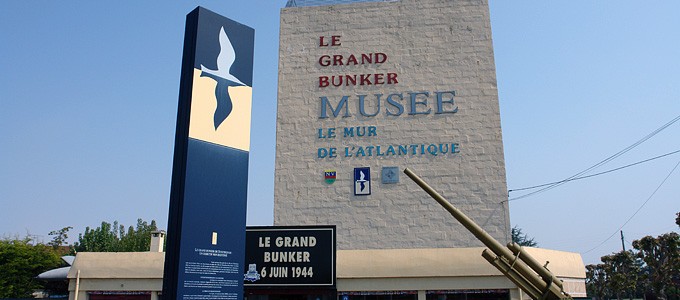On the Grand Bunker's six floors visitors can roam all its inner rooms, which have been recreated down to the last detail: generator room, gas filters room, casemate with machine gun protecting the entrance, dormitory, medical store, sick bay, armoury, ammunition store, radio transmission room, telephone switchboard, observation post equipped with a powerful range-finder, and on the top floor a 360° view over the area of Sword Beach and the Bay of the Seine from Le Havre (northeast) to Quinéville (northwest).
Many photographs, documents and items concerning the construction of the Atlantic Wall, the artillery, the beach defences, etc. are presented. The Museum also offers an insight into the tactics of the shock troops specially trained for the D-Day operations against the Atlantic Wall defences, as well as the everyday life of the German Army soldiers.
History of the bunker
On June 9, 1944, the “Great Bunker”, the centerpiece of the Atlantic Wall on the British sector of Sword Beach, surrendered its arms three days after the British landed.
Facing the sea, the area of Riva Bella has been fortified by the Germans around to defensive positions : Wn 10 and St P8 (Stützpunkt 08, six 155mm french guns), with about forty fortified and armed points, defended by minefields, ditches anti tanks, networks and barbered wire, beach obstacles.
Beginning in 1943, the artillery guns were protected by a large 1200 m long dugout from the estuary and 200 m deep. In May 1944, four casemates were under construction. While waiting for the end of the construction, and to prevent them from being destroyed by increasingly frequent aerial bombardments by the Allies, the guns were moved east of Saint-Aubin-d'Arquenay where they will still be on June 6.
Overlooking the sea, a firing control post, the « great bunker », was built from 1942 as part of the construction of the Atlantic Wall.
At 17 meters high and distributed over 5 levels, this concrete tower provided an exceptional point of view to the German artillery observers who installed their rangefinder on the fifth level. It is this observation post which must give the fire instructions to the 6 battery guns.
When the British Commandos landed on Sword Beach and advanced towards Riva Bella, the surprise was total. This fortification had not been identified in the aerial photographs, and did not appear on the records provided by the French Resistance. On the other hand, the British knew that 6 155mm guns were installed near the locks of the port. But this morning, the artillery pieces disappeared, they were moved back towards Saint-Aubin-d'Arquenay to be sheltered from bombing.
For three days British did not take into account this concrete tower which clearly represented no danger. Until June 9, the engineer troops realized that it was still occupied. In the evening, the decision was made to launch an assault. The firing control position fell into the hands of lieutenant Bob Orrell and three of his men from the Royal Engineers (9th Field Company, 3rd Beach Group).
After breaking into the bunker by destroying the armoured access door with explosive charges, they took prisoner the garrison of the 53 German soldiers who had been entrenched there since dawn on June 6.
Le Grand Bunker, Ouistreham, France
+ 33 (0)2 31 97 28 69, museegrandbunker@sfr.fr
